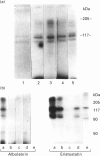Abstract
Viper venom disintegrins contain the RGD/KGD motif. They inhibit platelet aggregation and cell adhesion, but show structural and functional heterogeneity. We investigated the interaction of four prototypic disintegrins with alpha IIb beta 3 expressed on the surface of resting and activated platelets. The binding affinity (Kd) of 125I-albolabrin, 125I-echistatin, 125I-bitistatin and 125I-eristostatin toward resting platelets was 294, 153, 48 and 18 nM respectively. The Kd value for albolabrin decreased 3-fold and 6-fold after ADP- or thrombin-induced activation. The Kd values for bitistatin and echistatin also decreased with ADP, but there was no further decrease with thrombin. In contrast, eristostatin bound with the same high affinity to resting and activated platelets. The pattern of fluorescein isothiocyanate (FITC)-eristostatin and FITC-albolabrin binding to resting and activated platelets was consistent with observations using radiolabelled material. Eristostatin showed faster and more irreversible binding to platelets, and greater potency compared with albolabrin in inducing conformational neo-epitopes in beta 3. The anti-alpha IIb beta 3 monoclonal antibody OP-G2 that is RGD-dependent inhibited disintegrin binding to activated platelets more strongly than binding to resting platelets and it inhibited the binding to platelets of albolabrin more strongly than eristostatin. The specificity of disintegrin interaction with alpha IIb beta 3 was confirmed by demonstrating cross-linking of these peptides to alpha IIb beta 3 on normal platelets, but not to thrombasthenic platelets deficient in alpha IIb beta 3.
Full text
PDF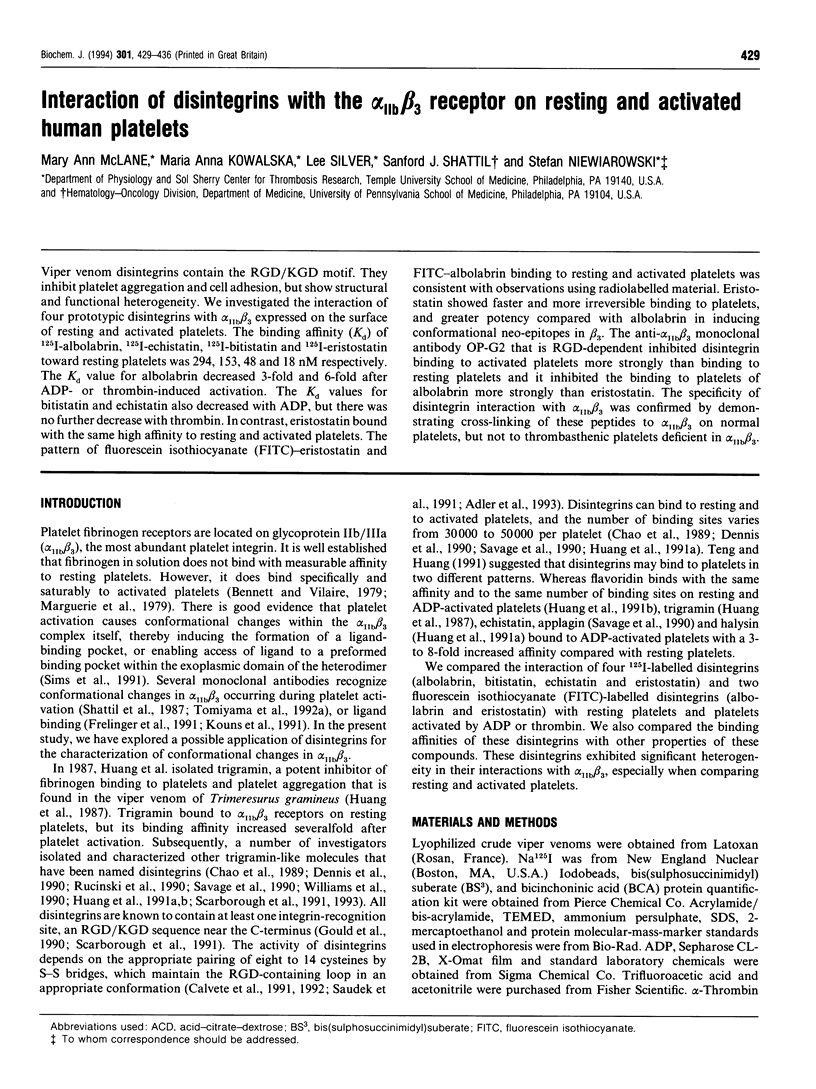

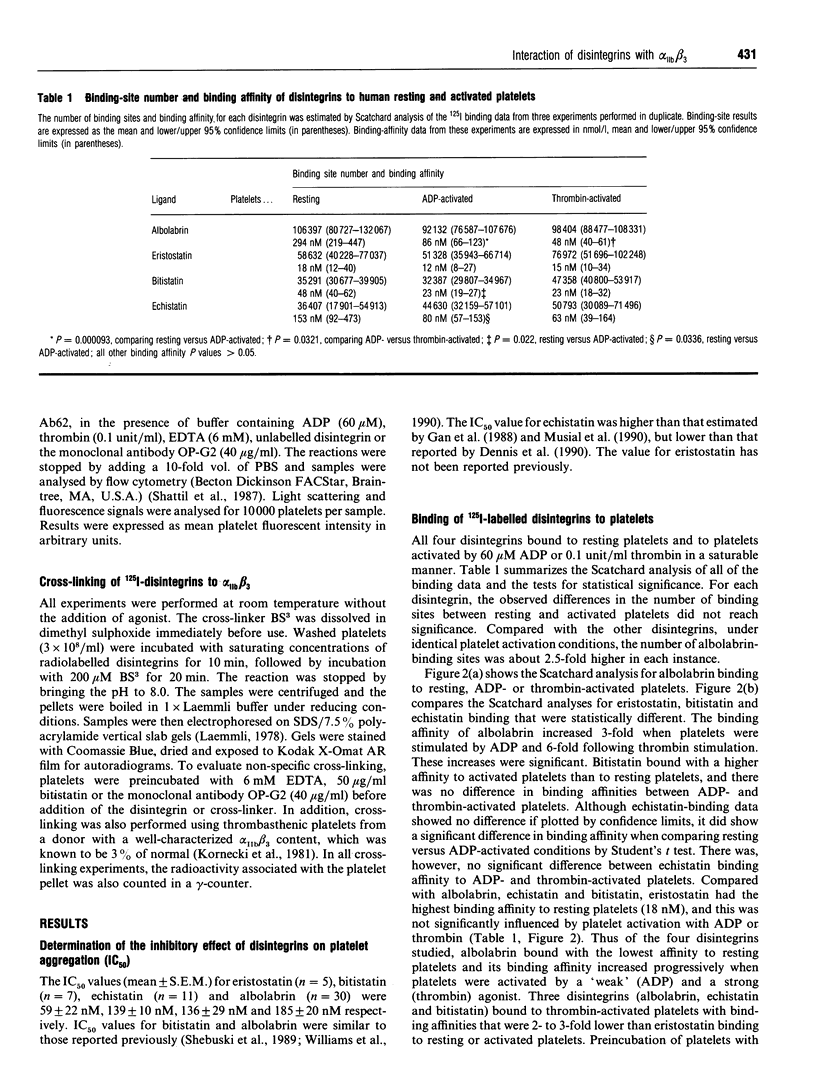
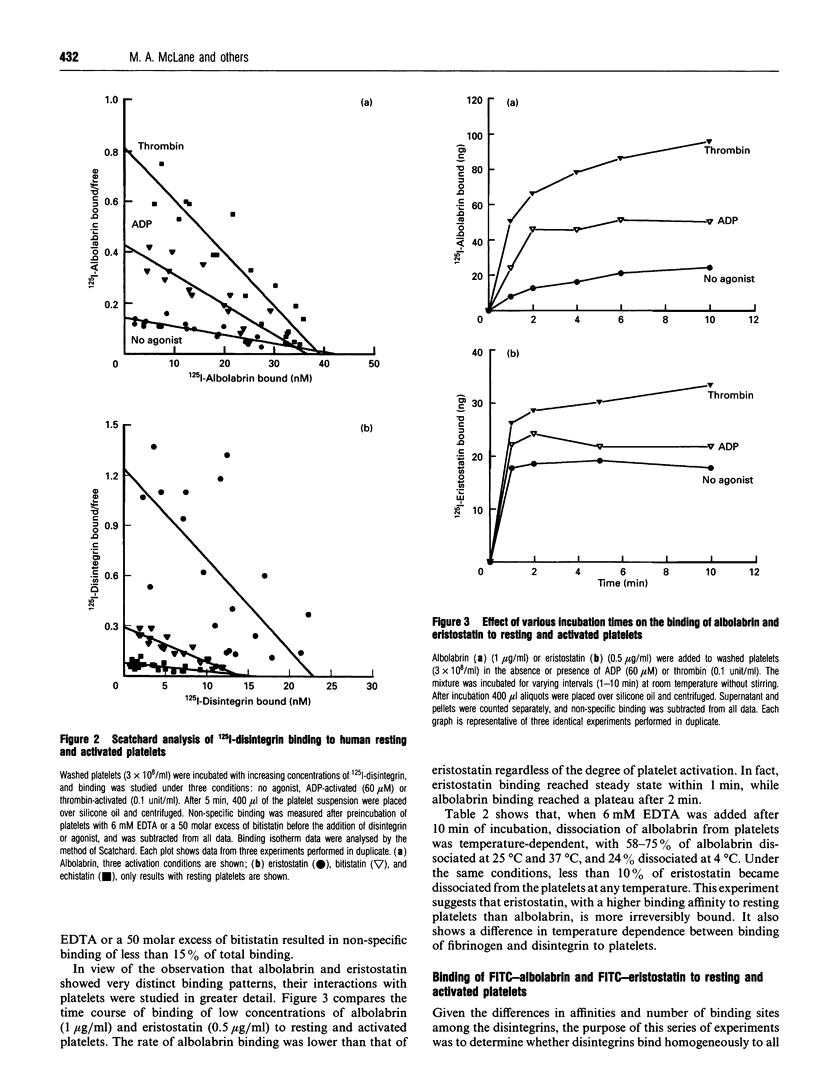

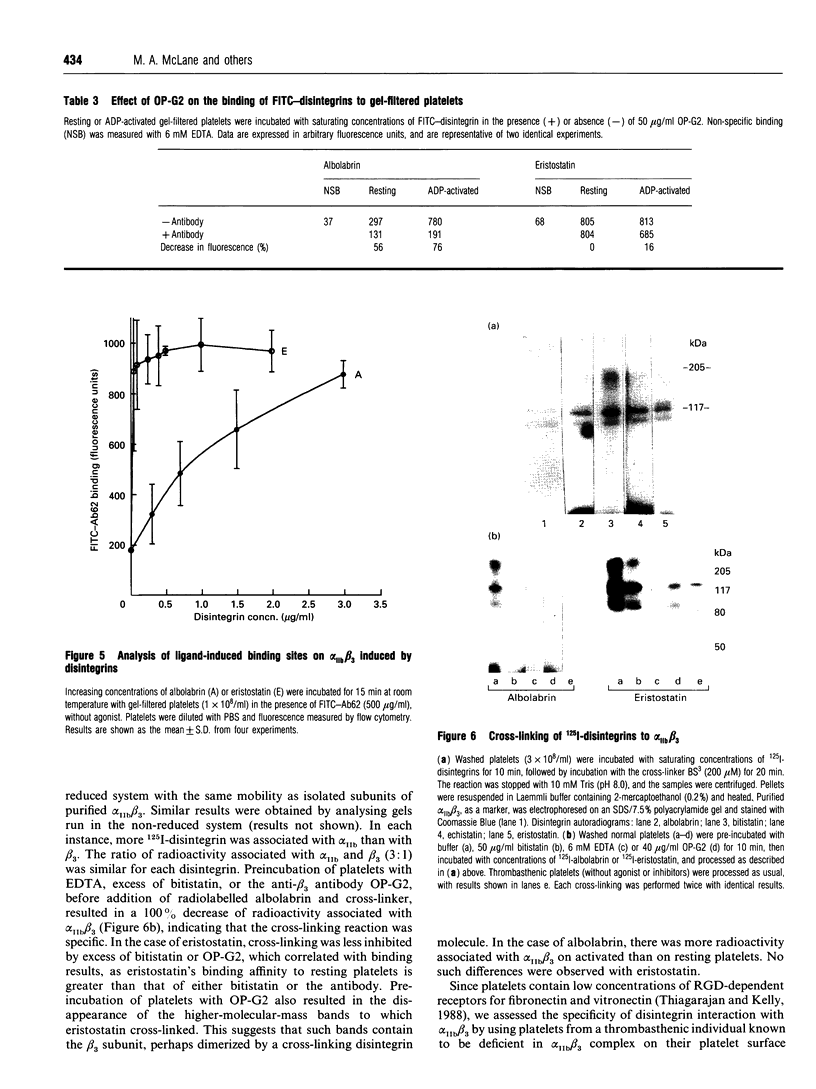
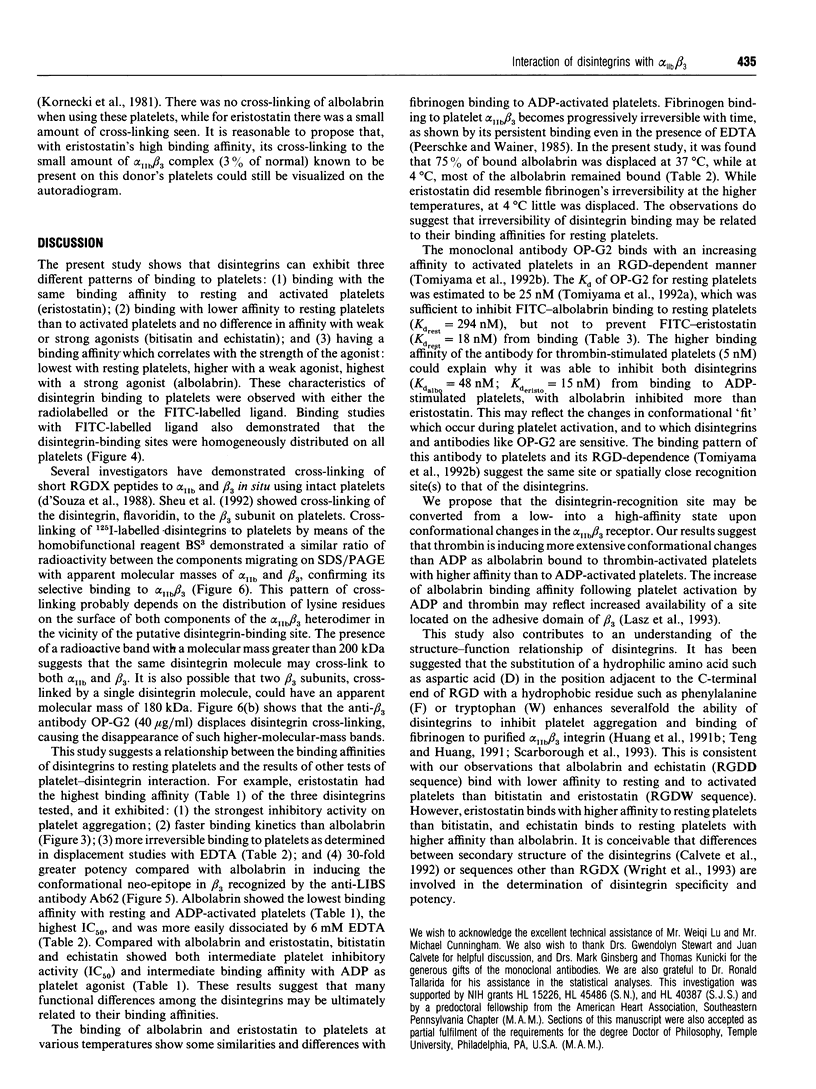

Images in this article
Selected References
These references are in PubMed. This may not be the complete list of references from this article.
- Adler M., Carter P., Lazarus R. A., Wagner G. Cysteine pairing in the glycoprotein IIbIIIa antagonist kistrin using NMR, chemical analysis, and structure calculations. Biochemistry. 1993 Jan 12;32(1):282–289. doi: 10.1021/bi00052a036. [DOI] [PubMed] [Google Scholar]
- Bennett J. S., Vilaire G. Exposure of platelet fibrinogen receptors by ADP and epinephrine. J Clin Invest. 1979 Nov;64(5):1393–1401. doi: 10.1172/JCI109597. [DOI] [PMC free article] [PubMed] [Google Scholar]
- Calvete J. J., Schäfer W., Mann K., Henschen A., González-Rodríguez J. Localization of the cross-linking sites of RGD and KQAGDV peptides to the isolated fibrinogen receptor, the human platelet integrin glycoprotein IIb/IIIa. Influence of peptide length. Eur J Biochem. 1992 Jun 15;206(3):759–765. doi: 10.1111/j.1432-1033.1992.tb16982.x. [DOI] [PubMed] [Google Scholar]
- Calvete J. J., Schäfer W., Soszka T., Lu W. Q., Cook J. J., Jameson B. A., Niewiarowski S. Identification of the disulfide bond pattern in albolabrin, an RGD-containing peptide from the venom of Trimeresurus albolabris: significance for the expression of platelet aggregation inhibitory activity. Biochemistry. 1991 May 28;30(21):5225–5229. doi: 10.1021/bi00235a016. [DOI] [PubMed] [Google Scholar]
- Chao B. H., Jakubowski J. A., Savage B., Chow E. P., Marzec U. M., Harker L. A., Maraganore J. M. Agkistrodon piscivorus piscivorus platelet aggregation inhibitor: a potent inhibitor of platelet activation. Proc Natl Acad Sci U S A. 1989 Oct;86(20):8050–8054. doi: 10.1073/pnas.86.20.8050. [DOI] [PMC free article] [PubMed] [Google Scholar]
- D'Souza S. E., Ginsberg M. H., Lam S. C., Plow E. F. Chemical cross-linking of arginyl-glycyl-aspartic acid peptides to an adhesion receptor on platelets. J Biol Chem. 1988 Mar 15;263(8):3943–3951. [PubMed] [Google Scholar]
- Dennis M. S., Henzel W. J., Pitti R. M., Lipari M. T., Napier M. A., Deisher T. A., Bunting S., Lazarus R. A. Platelet glycoprotein IIb-IIIa protein antagonists from snake venoms: evidence for a family of platelet-aggregation inhibitors. Proc Natl Acad Sci U S A. 1990 Apr;87(7):2471–2475. doi: 10.1073/pnas.87.7.2471. [DOI] [PMC free article] [PubMed] [Google Scholar]
- Frelinger A. L., 3rd, Du X. P., Plow E. F., Ginsberg M. H. Monoclonal antibodies to ligand-occupied conformers of integrin alpha IIb beta 3 (glycoprotein IIb-IIIa) alter receptor affinity, specificity, and function. J Biol Chem. 1991 Sep 15;266(26):17106–17111. [PubMed] [Google Scholar]
- Gan Z. R., Gould R. J., Jacobs J. W., Friedman P. A., Polokoff M. A. Echistatin. A potent platelet aggregation inhibitor from the venom of the viper, Echis carinatus. J Biol Chem. 1988 Dec 25;263(36):19827–19832. [PubMed] [Google Scholar]
- Gould R. J., Polokoff M. A., Friedman P. A., Huang T. F., Holt J. C., Cook J. J., Niewiarowski S. Disintegrins: a family of integrin inhibitory proteins from viper venoms. Proc Soc Exp Biol Med. 1990 Nov;195(2):168–171. doi: 10.3181/00379727-195-43129b. [DOI] [PubMed] [Google Scholar]
- Huang T. F., Holt J. C., Lukasiewicz H., Niewiarowski S. Trigramin. A low molecular weight peptide inhibiting fibrinogen interaction with platelet receptors expressed on glycoprotein IIb-IIIa complex. J Biol Chem. 1987 Nov 25;262(33):16157–16163. [PubMed] [Google Scholar]
- Huang T. F., Liu C. Z., Ouyang C. H., Teng C. M. Halysin, an antiplatelet Arg-Gly-Asp-containing snake venom peptide, as fibrinogen receptor antagonist. Biochem Pharmacol. 1991 Aug 22;42(6):1209–1219. doi: 10.1016/0006-2952(91)90256-5. [DOI] [PubMed] [Google Scholar]
- Huang T. F., Sheu J. R., Teng C. M., Chen S. W., Liu C. S. Triflavin, an antiplatelet Arg-Gly-Asp-containing peptide, is a specific antagonist of platelet membrane glycoprotein IIb-IIIa complex. J Biochem. 1991 Feb;109(2):328–334. [PubMed] [Google Scholar]
- Kornecki E., Niewiarowski S., Morinelli T. A., Kloczewiak M. Effects of chymotrypsin and adenosine diphosphate on the exposure of fibrinogen receptors on normal human and Glanzmann's thrombasthenic platelets. J Biol Chem. 1981 Jun 10;256(11):5696–5701. [PubMed] [Google Scholar]
- Kouns W. C., Newman P. J., Puckett K. J., Miller A. A., Wall C. D., Fox C. F., Seyer J. M., Jennings L. K. Further characterization of the loop structure of platelet glycoprotein IIIa: partial mapping of functionally significant glycoprotein IIIa epitopes. Blood. 1991 Dec 15;78(12):3215–3223. [PubMed] [Google Scholar]
- Laemmli U. K. Cleavage of structural proteins during the assembly of the head of bacteriophage T4. Nature. 1970 Aug 15;227(5259):680–685. doi: 10.1038/227680a0. [DOI] [PubMed] [Google Scholar]
- Lasz E. C., McLane M. A., Trybulec M., Kowalska M. A., Khan S., Budzynski A. Z., Niewiarowski S. Beta 3 integrin derived peptide 217-230 inhibits fibrinogen binding and platelet aggregation: significance of RGD sequences and fibrinogen A alpha-chain. Biochem Biophys Res Commun. 1993 Jan 15;190(1):118–124. doi: 10.1006/bbrc.1993.1019. [DOI] [PubMed] [Google Scholar]
- Marguerie G. A., Plow E. F., Edgington T. S. Human platelets possess an inducible and saturable receptor specific for fibrinogen. J Biol Chem. 1979 Jun 25;254(12):5357–5363. [PubMed] [Google Scholar]
- Musial J., Niewiarowski S., Rucinski B., Stewart G. J., Cook J. J., Williams J. A., Edmunds L. H., Jr Inhibition of platelet adhesion to surfaces of extracorporeal circuits by disintegrins. RGD-containing peptides from viper venoms. Circulation. 1990 Jul;82(1):261–273. doi: 10.1161/01.cir.82.1.261. [DOI] [PubMed] [Google Scholar]
- Mustard J. F., Perry D. W., Ardlie N. G., Packham M. A. Preparation of suspensions of washed platelets from humans. Br J Haematol. 1972 Feb;22(2):193–204. doi: 10.1111/j.1365-2141.1972.tb08800.x. [DOI] [PubMed] [Google Scholar]
- Niewiarowski S., Budzynski A. Z., Morinelli T. A., Brudzynski T. M., Stewart G. J. Exposure of fibrinogen receptor on human platelets by proteolytic enzymes. J Biol Chem. 1981 Jan 25;256(2):917–925. [PubMed] [Google Scholar]
- Peerschke E. I., Wainer J. A. Examination of irreversible platelet-fibrinogen interactions. Am J Physiol. 1985 May;248(5 Pt 1):C466–C472. doi: 10.1152/ajpcell.1985.248.5.C466. [DOI] [PubMed] [Google Scholar]
- Rucinski B., Niewiarowski S., Holt J. C., Soszka T., Knudsen K. A. Batroxostatin, an Arg-Gly-Asp-containing peptide from Bothrops atrox, is a potent inhibitor of platelet aggregation and cell interaction with fibronectin. Biochim Biophys Acta. 1990 Sep 24;1054(3):257–262. doi: 10.1016/0167-4889(90)90096-v. [DOI] [PubMed] [Google Scholar]
- Saudek V., Atkinson R. A., Pelton J. T. Three-dimensional structure of echistatin, the smallest active RGD protein. Biochemistry. 1991 Jul 30;30(30):7369–7372. doi: 10.1021/bi00244a003. [DOI] [PubMed] [Google Scholar]
- Savage B., Marzec U. M., Chao B. H., Harker L. A., Maraganore J. M., Ruggeri Z. M. Binding of the snake venom-derived proteins applaggin and echistatin to the arginine-glycine-aspartic acid recognition site(s) on platelet glycoprotein IIb.IIIa complex inhibits receptor function. J Biol Chem. 1990 Jul 15;265(20):11766–11772. [PubMed] [Google Scholar]
- Scarborough R. M., Rose J. W., Hsu M. A., Phillips D. R., Fried V. A., Campbell A. M., Nannizzi L., Charo I. F. Barbourin. A GPIIb-IIIa-specific integrin antagonist from the venom of Sistrurus m. barbouri. J Biol Chem. 1991 May 25;266(15):9359–9362. [PubMed] [Google Scholar]
- Scarborough R. M., Rose J. W., Naughton M. A., Phillips D. R., Nannizzi L., Arfsten A., Campbell A. M., Charo I. F. Characterization of the integrin specificities of disintegrins isolated from American pit viper venoms. J Biol Chem. 1993 Jan 15;268(2):1058–1065. [PubMed] [Google Scholar]
- Shattil S. J., Cunningham M., Hoxie J. A. Detection of activated platelets in whole blood using activation-dependent monoclonal antibodies and flow cytometry. Blood. 1987 Jul;70(1):307–315. [PubMed] [Google Scholar]
- Shebuski R. J., Ramjit D. R., Bencen G. H., Polokoff M. A. Characterization and platelet inhibitory activity of bitistatin, a potent arginine-glycine-aspartic acid-containing peptide from the venom of the viper Bitis arietans. J Biol Chem. 1989 Dec 25;264(36):21550–21556. [PubMed] [Google Scholar]
- Sheu J. R., Teng C. M., Huang T. F. Triflavin, an RGD-containing antiplatelet peptide, binds to GpIIIa of ADP-stimulated platelets. Biochem Biophys Res Commun. 1992 Dec 15;189(2):1236–1242. doi: 10.1016/0006-291x(92)92337-w. [DOI] [PubMed] [Google Scholar]
- Sims P. J., Ginsberg M. H., Plow E. F., Shattil S. J. Effect of platelet activation on the conformation of the plasma membrane glycoprotein IIb-IIIa complex. J Biol Chem. 1991 Apr 25;266(12):7345–7352. [PubMed] [Google Scholar]
- Thiagarajan P., Kelly K. L. Exposure of binding sites for vitronectin on platelets following stimulation. J Biol Chem. 1988 Feb 25;263(6):3035–3038. [PubMed] [Google Scholar]
- Tomiyama Y., Brojer E., Ruggeri Z. M., Shattil S. J., Smiltneck J., Gorski J., Kumar A., Kieber-Emmons T., Kunicki T. J. A molecular model of RGD ligands. Antibody D gene segments that direct specificity for the integrin alpha IIb beta 3. J Biol Chem. 1992 Sep 5;267(25):18085–18092. [PubMed] [Google Scholar]
- Tomiyama Y., Tsubakio T., Piotrowicz R. S., Kurata Y., Loftus J. C., Kunicki T. J. The Arg-Gly-Asp (RGD) recognition site of platelet glycoprotein IIb-IIIa on nonactivated platelets is accessible to high-affinity macromolecules. Blood. 1992 May 1;79(9):2303–2312. [PubMed] [Google Scholar]
- Williams J., Rucinski B., Holt J., Niewiarowski S. Elegantin and albolabrin purified peptides from viper venoms: homologies with the RGDS domain of fibrinogen and von Willebrand factor. Biochim Biophys Acta. 1990 May 31;1039(1):81–89. doi: 10.1016/0167-4838(90)90229-9. [DOI] [PubMed] [Google Scholar]
- Wright P. S., Saudek V., Owen T. J., Harbeson S. L., Bitonti A. J. An echistatin C-terminal peptide activates GPIIbIIIa binding to fibrinogen, fibronectin, vitronectin and collagen type I and type IV. Biochem J. 1993 Jul 1;293(Pt 1):263–267. doi: 10.1042/bj2930263. [DOI] [PMC free article] [PubMed] [Google Scholar]



